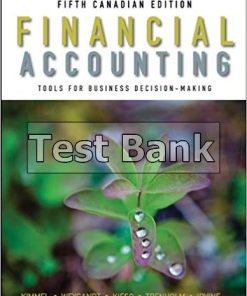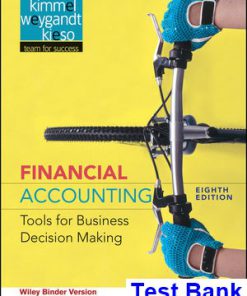1 Introduction to Financial Statements 1-1
Knowing the Numbers: Columbia Sportswear Company 1-1
1.1 Business Organization and Accounting Information Uses 1-2
1.2 The Three Types of Business Activity 1-8
1.3 The Four Financial Statements 1-11
Appendix 1A: Career Opportunities in Accounting 1-23
2 A Further Look at Financial Statements 2-1
Just Fooling Around?: The Motley Fool 2-2
2.1 The Classified Balance Sheet 2-3
2.2 Analyzing the Financial Statements Using Ratios 2-8
2.3 Financial Reporting Concepts 2-14
3 The Accounting Information System 3-1
Accidents Happen: MF Global Holdings Ltd 3-1
3.1 Using the Accounting Equation to Analyze Transactions 3-3
3.2 Accounts, Debits, and Credits 3-11
3.3 Using a Journal 3-17
3.4 The Ledger and Posting 3-20
3.5 The Trial Balance 3-30
4 Accrual Accounting Concepts 4-1
Keeping Track of Groupons: Groupon 4-1
4.1 Accrual-Basis Accounting and Adjusting Entries 4-2
4.2 Adjusting Entries for Deferrals 4-7
4.3 Adjusting Entries for Accruals 4-15
4.4 The Adjusted Trial Balance and Closing Entries 4-23
Appendix 4A: Using a Worksheet 4-34
5 Merchandising Operations and the Multiple-Step Income Statement 5-1
Buy Now, Vote Later: REI 5-1
5.1 Merchandising Operations and Inventory Systems 5-2
5.2 Recording Purchases Under a Perpetual System 5-6
5.3 Recording Sales Under a Perpetual System 5-11
5.4 Preparing the Multiple-Step Income Statement 5-16
5.5 Cost of Goods Sold Under a Periodic System 5-21
5.6 Gross Profit Rate and Profit Margin 5-23
Appendix 5A: Periodic Inventory System 5-27
Appendix 5B: Adjusting Entries for Credit Sales with Returns and Allowances 5-30
6 Reporting and Analyzing Inventory 6-1
“Where Is That Spare Bulldozer Blade?”: Caterpillar 6-1
6.1 Classifying and Determining Inventory 6-2
6.2 Inventory Methods and Financial Effects 6-7
6.3 Inventory Presentation and Analysis 6-17
Appendix 6A: Inventory Cost Flow Methods in Perpetual Inventory Systems 6-24
Appendix 6B: Effects of Inventory Errors 6-27
7 Fraud, Internal Control, and Cash 7-1
Minding the Money in Madison: Barriques 7-1
7.1 Fraud and Internal Control 7-3
7.2 Cash Controls 7-12
7.3 Control Features of a Bank Account 7-17
7.4 Reporting Cash 7-25
Appendix 7A: Operation of a Petty Cash Fund 7-32
8 Reporting and Analyzing Receivables 8-1
What’s Cooking?: Nike 8-1
8.1 Recognition of Accounts Receivable 8-3
8.2 Valuation and Disposition of Accounts Receivable 8-5
8.3 Notes Receivable 8-15
8.4 Receivables Presentation and Management 8-20
9 Reporting and Analyzing Long-Lived Assets 9-1
A Tale of Two Airlines: American Airlines 9-1
9.1 Plant Asset Expenditures 9-3
9.2 Depreciation Methods 9-8
9.3 Plant Asset Disposals 9-16
9.4 Intangible Assets 9-19
9.5 Statement Presentation and Analysis 9-23
Appendix 9A: Other Depreciation Methods 9-30
10 Reporting and Analyzing Liabilities 10-1
And Then There Were Two: Maxwell Car Company 10-1
10.1 Accounting for Current Liabilities 10-3
10.2 Characteristics of Bonds 10-9
10.3 Accounting for Bond Transactions 10-14
10.4 Presentation and Analysis 10-20
Appendix 10A: Straight-Line Amortization 10-26
Appendix 10B: Effective-Interest Amortization 10-29
Appendix 10C: Accounting for Long-Term Notes Payable 10-32
11 Reporting and Analyzing Stockholders’ Equity 11-1
Oh Well, I Guess I’ll Get Rich: Facebook 11-1
11.1 Corporate Form of Organization 11-3
11.2 Accounting for Common, Preferred, and Treasury Stock 11-12
11.3 Accounting for Dividends and Stock Splits 11-16
11.4 Presentation and Analysis 11-24
Appendix 11A: Entries for Stock Dividends 11-32
12 Statement of Cash Flows 12-1
Got Cash?: Microsoft 12-2
12.1 Usefulness and Format of the Statement of Cash Flows 12-3
12.2 Preparing the Statement of Cash Flows—Indirect Method 12-6
12.3 Analyzing the Statement of Cash Flows 12-17
Appendix 12A: Statement of Cash Flows—Direct Method 12-22
Appendix 12B: Worksheet for the Indirect Method 12-30
Appendix 12C: Statement of Cash Flows—T-Account Approach 12-35
13 Financial Analysis: The Big Picture 13-1
It Pays to Be Patient: Warren Buffett 13-2
13.1 Sustainable Income and Quality of Earnings 13-3
13.2 Horizontal Analysis and Vertical Analysis 13-9
13.3 Ratio Analysis 13-15
14 Managerial Accounting 14-1
Just Add Water … and Paddle: Current Designs 14-1
14.1 Managerial Accounting Basics 14-3
14.2 Managerial Cost Concepts 14-7
14.3 Manufacturing Costs in Financial Statements 14-12
14.4 Managerial Accounting Today 14-16
15 Job Order Costing 15-1
Profiting from the Silver Screen: Disney 15-1
15.1 Cost Accounting Systems 15-3
5.2 Assigning Manufacturing Costs 15-8
15.3 Predetermined Overhead Rates 15-13
15.4 Entries for Jobs Completed and Sold 15-16
15.5 Applied Manufacturing Overhead 15-22
16 Process Costing 16-1
The Little Guy Who Could: Jones Soda 16-1
16.1 Overview of Process Cost Systems 16-3
16.2 Process Cost Flow and Assigning Costs 16-6
16.3 Equivalent Units 16-10
16.4 The Production Cost Report 16-13
Appendix 16A: FIFO Method for Equivalent Units 16-21
17 Activity-Based Costing 17-1
Precor Is on Your Side: Precor17-1
17.1 Traditional vs. Activity-Based Costing 17-3
17.2 ABC and Manufacturers 17-7
17.3 ABC Benefits and Limitations 17-13
17.4 ABC and Service Industries 17-20
18 Cost-Volume-Profit 18-1
Don’t Worry—Just Get Big: Amazon.com 18-1
18.1 Cost Behavior Analysis 18-3
18.2 Mixed Costs Analysis 18-8
18.3 Cost-Volume-Profit Analysis 18-11
18.4 Break-Even Analysis 18-16
18.5 Target Net Income and Margin of Safety 18-20
Appendix 18A: Regression Analysis 18-24
19 Cost-Volume-Profit Analysis: Additional Issues 19-1
Not Even a Flood Could Stop It: Whole Foods Market 19-1
19.1 Basic CVP Concepts 19-3
19.2 Sales Mix and Break-Even Sales 19-7
19.3 Sales Mix with Limited Resources 19-13
19.4 Operating Leverage and Profitability 19-15
Appendix 19A: Absorption Costing versus Variable Costing 19-20
20 Incremental Analysis 20-1
Keeping It Clean: Method Products 20-1
20.1 Decision-Making and Incremental Analysis 20-3
20.2 Special Orders 20-6
20.3 Make or Buy 20-8
20.4 Sell or Process Further 20-11
20.5 Repair, Retain, or Replace Equipment 20-14
20.6 Eliminate Unprofitable Segment or Product 20-16
21 Pricing 21-1
They’ve Got Your Size—and Color: Zappos.com 21-1
21.1 Target Costing 21-3
21.2 Cost-Plus and Variable-Cost Pricing 21-5
21.3 Time-and-Material Pricing 21-10
21.4 Transfer Prices 21-13
Appendix 21A: Absorption-Cost and Variable-Cost Pricing 21-22
Appendix 21B: Transfers Between Divisions in Different Countries 21-26
22 Budgetary Planning 22-1
What’s in Your Cupcake?: Erin McKenna’s Bakery NYC 22-1
22.1 Effective Budgeting and the Master Budget 22-3
22.2 Sales, Production, and Direct Materials Budgets 22-8
22.3 Direct Labor, Manufacturing Overhead, and S&A Expense Budgets 22-14
22.4 Cash Budget and Budgeted Balance Sheet 22-18
22.5 Budgeting in Nonmanufacturing Companies 22-23
23 Budgetary Control and Responsibility Accounting 23-1
Pumpkin Madeleines and a Movie: The Roxy HotelTribeca 23-1
23.1 Budgetary Control and Static Budget Reports 23-3
23.2 Flexible Budget Reports 23-7
23.3 Responsibility Accounting and Responsibility Centers 23-14
23.4 Investment Centers 23-24
Appendix 23A: ROI versus Residual Income 23-30
24 Standard Costs and Balanced Scorecard 24-1
80,000 Different Caffeinated Combinations: Starbucks 24-2
24.1 Overview of Standard Costs 24-3
24.2 Direct Materials Variances 24-8
24.3 Direct Labor and Manufacturing Overhead Variances 24-13
24.4 Variance Reports and Balanced Scorecards 24-18
Appendix 24A: Standard Cost Accounting System 24-24
Appendix 24B: Overhead Controllable and Volume Variances 24-26
25 Planning for Capital Investments 25-1
Floating Hotels: Holland America Line 25-2
25.1 Capital Budgeting and Cash Payback 25-3
25.2 Net Present Value Method 25-6
25.3 Capital Budgeting Challenges and Refinements 25-12
25.4 Internal Rate of Return 25-17
25.5 Annual Rate of Return 25-20
APPENDIX A Specimen Financial Statements: Apple Inc. A-1
APPENDIX B Specimen Financial Statements: Columbia Sportswear Company B-1
APPENDIX C Specimen Financial Statements: Under Armour, Inc. C-1
APPENDIX D Specimen Financial Statements: Amazon.com, Inc. D-1
APPENDIX E Specimen Financial Statements: Walmart Inc. E-1
APPENDIX F Time Value of Money F-1
APPENDIX G Reporting and Analyzing Investments G-1
Available in Wiley Course Resources and Wiley Custom:
*APPENDIX H Payroll Accounting H-1
H.1 Recording the Payroll H-1
H.2 Employer Payroll Taxes H-8
H.3 Internal Control for Payroll H-11
*APPENDIX I Subsidiary Ledgers and Special Journals I-1
I.1 Subsidiary Ledgers I-1
I.2 Special Journals I-4
*APPENDIX J Accounting for Partnerships J-1
J.1 Forming a Partnership J-1
J.2 Accounting for Partnership Net Income or Net Loss J-6
J.3 Accounting for Partnership Liquidation J-11
J.4 Admission and Withdrawal of Partners J-15
APPENDIX K Accounting for Sole Proprietorships K-1
K.1 Corporation versus Sole Proprietorship Equity Accounts K-1
K.2 Accounts that Change Owner’s Equity K-2
K.3 Retained Earnings Statement versus Owner’s Equity Statement K-4
K.4 Closing the Books for a Sole Proprietorship K-5
CHAPTER 15A Job Order Costing (nondebit-and-credit approach)
CHAPTER 16A Process Costing (nondebit-and-credit-approach)
Cases for Management Decision Making













